
Chiang Mai Street Food: An Ultimate Guide on What to Try & How to Order Safely
Discover the authentic tastes of Northern Thailand with our ultimate guide to Chiang Mai Street food. From spicy Khao Soi to sweet mango sticky rice, explore the best night markets and hidden stalls that locals love.
11/23/20259 min read


The Ultimate Guide to Chiang Mai's Street Food: What to Try and How to Order Safely
The true, beating heart of Chiang Mai is not found inside its ancient temples or on its misty mountain tops. It’s found on its sidewalks, after the sun goes down.
It’s the hiss of a wok in a plume of fire. It’s the intoxicating aroma of charcoal-grilled pork and lemongrass. It's the sweet, nutty smell of coconut pancakes sizzling in a cast-iron pan. This is the symphony of Chiang Mai street food—a world of flavor that is vibrant, chaotic, complex, and utterly delicious.
But let’s be honest. For a first-time visitor, that world can also be intimidating. We’ve all heard the stories—the hesitant traveler, worried about "back-alley" food, pointing nervously at an unidentifiable skewer, and ending up with a sad plate of plain rice. Or worse, the traveler who avoids it altogether, sticking to hotel restaurants and missing out on the single most authentic cultural experience the city has to in offer.
Here’s the secret: Street food isn't just part of the culture in Chiang Mai; it is the culture.
And it is not only delicious—it can be eaten safely, confidently, and joyfully, even if you don't speak a word of Thai. This is not just a guide to what to eat. This is a guide on how to eat.
We’re here to give you the confidence to dive in headfirst. We’ll show you how to spot the best stalls, what dishes are absolute must-tries, and how to navigate the ordering process. Forget your fears. Get ready to eat.
Part 1: The Golden Rules: How to Eat Street Food Safely
Before we get to the delicious part, let’s build your confidence. The fear of getting sick is real, but it’s almost entirely avoidable if you follow a few simple, local-approved rules.
1. The Golden Rule: Follow the Crowd
This is the single most important rule. If you see a food stall with a long line of locals—students, families, songthaew drivers—get in that line. A crowd is not an inconvenience; it’s a guarantee. It tells you two things:
It’s delicious: Locals know where the best food is. They will not waste time on a stall that makes a mediocre Pad Thai.
It’s fresh: A busy stall has high turnover. The ingredients aren’t sitting around for hours. They are being constantly replenished and cooked, meaning everything is fresher and safer.
Conversely, a stall with no customers at 7 PM should be avoided.
2. Watch the Preparation: "Fresh is Best"
The beauty of street food is its transparency. You're not eating from a mysterious kitchen behind closed doors. The "kitchen" is right in front of you. Use this to your advantage.
Wok-to-Plate: Look for food that is made-to-order. Is the vendor cooking your noodles right now, in a blazing hot wok? Perfect.
Pre-Cooked Trays: Be cautious of stalls with large trays of pre-cooked food sitting out at room temperature. The only exception is if these trays are clearly just for display and the vendor is grabbing fresh ingredients from a cooler to cook with.
3. The "Heat" Rule: Hot Food is Safe Food
This is simple food science. High heat kills bacteria.
Boiling Soups: A vat of soup that is at a rolling boil is perfectly safe.
Sizzling Grills: Skewers cooked over white-hot charcoal are a great choice.
Deep-Fried: While not the healthiest, a deep-fryer (like for gai tod or spring rolls) is so hot that it’s one of the safest things you can eat.
4. The Water & Ice Myth
This is the #1 fear for most travelers. Let's clear it up.
Tap Water: Do not drink the tap water in Chiang Mai. Period.
Ice: Ice is perfectly safe. The ice in Thailand (even on the street) is not made from tap water. It is produced in factories using filtered, purified water and delivered in bags. You’ll often see it as uniform tubes with a hole in the middle. Do not be afraid to order an iced coffee or a fruit smoothie. It’s a necessity in the heat, and it is safe.
Washed Veggies: The fresh herbs and vegetables you get as a garnish (like on your Khao Soi) are also safe. They are rinsed with clean water.
5. Trust Your Gut (and Your Senses)
This is the final rule. Use your common sense. Does the vendor's station look generally tidy (by street food standards)? Are they handling money and then raw food without washing? (Though many use a glove or tongs). Do the ingredients look fresh and vibrant, or wilted and sad? If something feels "off" to you, just walk away. There is another, better stall 10 steps away.
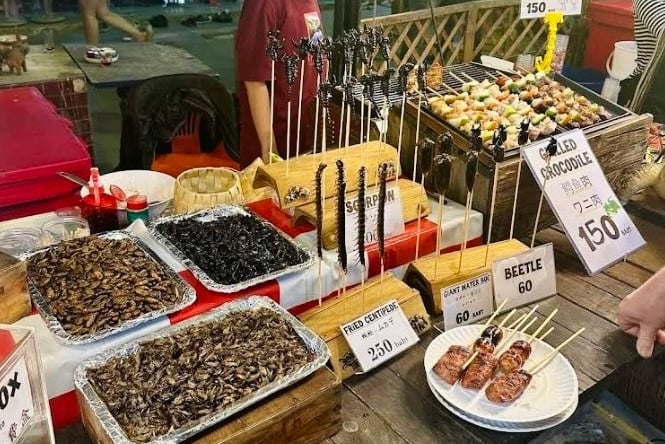

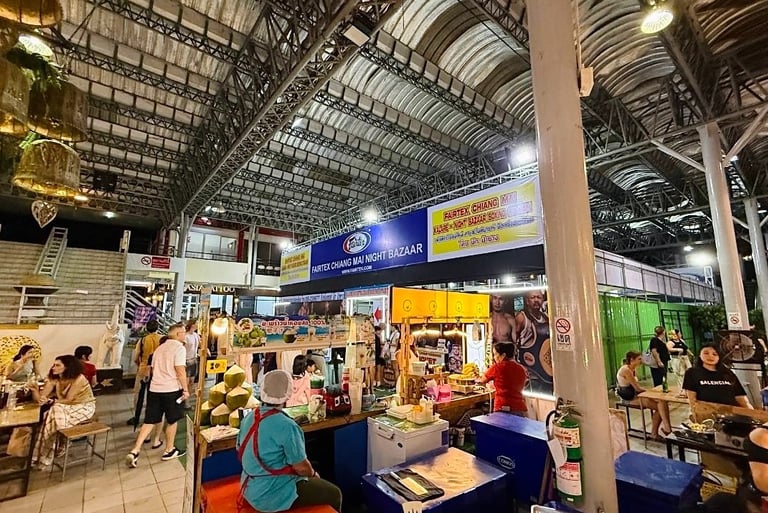



Part 2: The Must-Eat List: What to Try
Okay, now for the fun part. You’re confident. You’re hungry. Where do you begin? Here is the essential Chiang Mai street food checklist.
1. Khao Soi (ข้าวซอย)
This is the undisputed King of Northern Thai cuisine. If you only eat one dish, make it this. It’s a rich, creamy, coconut-based curry soup, often with a tender chicken drumstick or beef, served with soft egg noodles in the broth and a crown of crispy-fried egg noodles on top. It's served with a side of pickled mustard greens, shallots, and lime. The combination of creamy, spicy, savory, and crunchy is pure magic.
Note: While Khao Soi is often found in restaurants, many night markets have stalls that serve fantastic versions.
2. Sai Oua (ไส้อั่ว)
This is the "Chiang Mai Sausage," and it's a flavor explosion. It’s a coarse-ground pork sausage packed with an incredible array of fresh herbs and spices—you'll taste lemongrass, kaffir lime, galangal, and chili. It's grilled over charcoal until smoky and sizzling. You’ll see it in long, beautiful coils. They will snip off a piece for you, and it’s often served with raw ginger and cabbage.
3. Khao Kha Moo (ข้าวขาหมู)
This is the ultimate comfort food. It’s pork leg, slow-braised for hours (and hours) in a sweet-savory broth of soy sauce, star anise, and other spices until it is so tender it literally melts in your mouth. It’s served over rice, drizzled with the braising liquid, and accompanied by a side of pickled greens and a hard-boiled egg.
Famous Stall: Look for the "Cowboy Hat Lady" at the Chang Phueak (North) Gate. She is a Chiang Mai icon, and her Khao Kha Moo is legendary.
4. Moo Ping (หมูปิ้ง)
Simple. Perfect. Moo Ping is grilled pork skewers. The pork is thinly sliced, marinated in a mix of coconut milk, fish sauce, and palm sugar, then threaded onto a skewer and grilled over charcoal. The result is a smoky, sweet, and impossibly tender snack. It’s often eaten with a small bag of khao niao (sticky rice). This is the perfect "walking around" food.
5. Som Tum (ส้มตำ) & Gai Yang (ไก่ย่าง)
This is the classic duo of the Isaan region (Northeast Thailand), but it’s a staple in Chiang Mai.
Som Tum: The famous spicy green papaya salad. Shredded green papaya is pounded in a mortar and pestle with chili, garlic, lime juice, fish sauce, and peanuts. It’s a fresh, fiery, and funky flavor bomb.
Gai Yang: Grilled chicken. Marinated in a savory-sweet sauce and grilled slowly until the skin is crispy and the meat is juicy. The combination of the spicy-sour salad, the savory chicken, and a side of sticky rice is one of the all-time great Thai meals.
6. Kanom Krok (ขนมครก)
Time for dessert. These are tiny, sweet and savory coconut-rice pancakes. A batter of rice flour, coconut milk, and sugar is poured into a special cast-iron pan, and as it cooks, it becomes crispy on the outside and impossibly soft and custardy on the inside. They are often served as little half-moons, sometimes topped with a bit of green onion or corn.
7. Khao Niao Mamuang (ข้าวเหนียวมะม่วง)
Mango Sticky Rice. This is the dessert that dreams are made of. Sweet, glutinous sticky rice is steamed with coconut milk, served with perfectly ripe, sweet mango, and then drizzled with even more sweet coconut cream and a sprinkle of toasted mung beans for crunch. It is, without exaggeration, perfection.
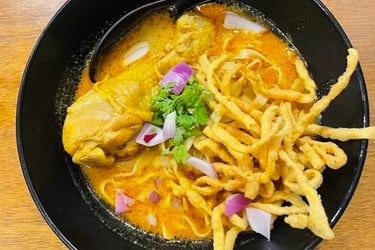

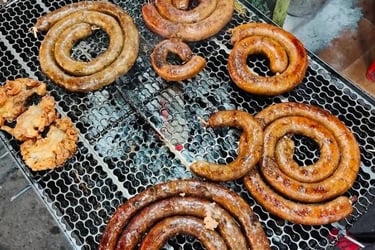

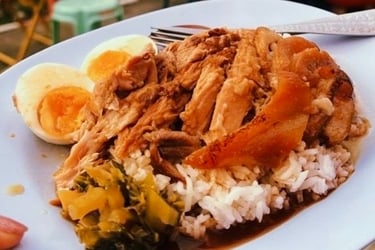

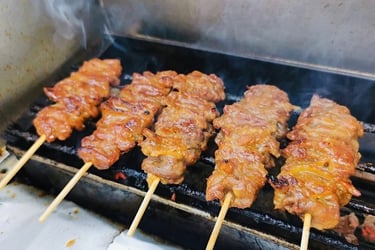

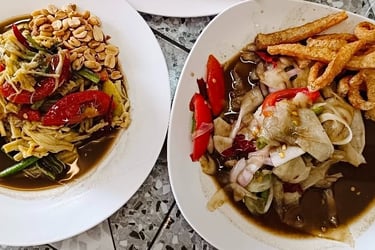

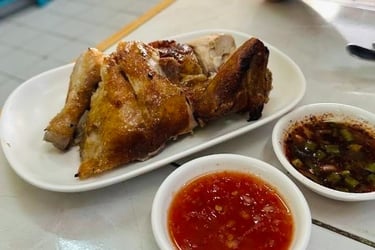

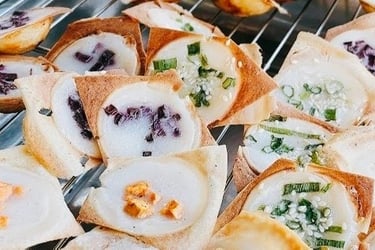

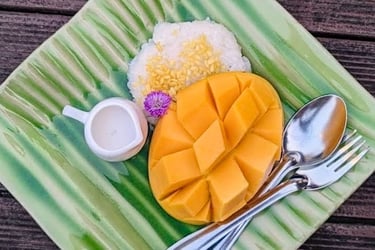

Part 3: How to Order Like a Local
Don’t speak Thai? Don’t worry. Ordering is easy.
The Pointing System: This is your best friend and 100% acceptable. Simply point at the food you want. If there are different options, the vendor will point, and you just nod.
The "How Much?": Hold up the food you want and ask, "Tao rai?" (How much?). The vendor will either tell you or, more likely, hold up the correct amount of fingers (e.g., "30" or "40" baht).
The Spice Question: This is important for Som Tum or noodle soups.
"Mai phet" (my-pet) = Not spicy.
"Phet nit noi" (pet-nit-noy) = A little spicy.
The "Thank You": After you pay, smile and say "Khop khun" (kop-koon). (If you are female, add "ka" at the end: "Khop khun ka." If you are male, add "krub" at the end: "Khop khun krub.")
Understanding the "Setup"
You’ll notice most noodle stalls have a rack of condiments on the table. This is the "four pillars" of Thai taste: sugar, chili flakes, fish sauce, and chili-infused vinegar. Your soup is served as a "base." You are expected to taste it and then customize it to your own liking.
Part 4: Where to Go: The Best Street Food Hubs
You're ready. But where do you find this food? While amazing stalls are hidden down almost every soi (alley), these are the major hubs where you can find everything in one place.
Chiang Mai Gate (South Gate) Market:
When: Evenings, from 5 PM until late.
The Vibe: This is arguably the best and most famous all-around street food market. The area around the gate (both inside and outside) comes alive with dozens of stalls. You can find everything here: Pad Thai, Som Tum, skewers, Kanom Krok, and dozens of fruit smoothie stalls. It's a one-stop-shop.
Chang Phueak Gate (North Gate) Market:
When: Evenings, from 5 PM until late.
The Vibe: This is the other major evening hub. While it has a good variety, it's most famous as the home of the "Cowboy Hat Lady" and her legendary Khao Kha Moo. It's worth the trip just for that.
When: Daytime (morning and afternoon).
The Vibe: This is Chiang Mai's oldest and largest market. While the main market is for clothes and goods, the surrounding streets are a paradise for daytime snacks. This is the best place to find fresh Sai Oua, Nam Prik (chili dips), and other local Lanna delicacies.
Saturday & Sunday Walking Streets:
When: Saturday (Wua Lai Road) and Sunday (Rachadamnoen Road) evenings.
The Vibe: These markets are part-craft fair, part-food festival. The food is fantastic, but it's slightly more expensive and geared towards tourists. The temple courtyards along the route are turned into massive, open-air food courts.
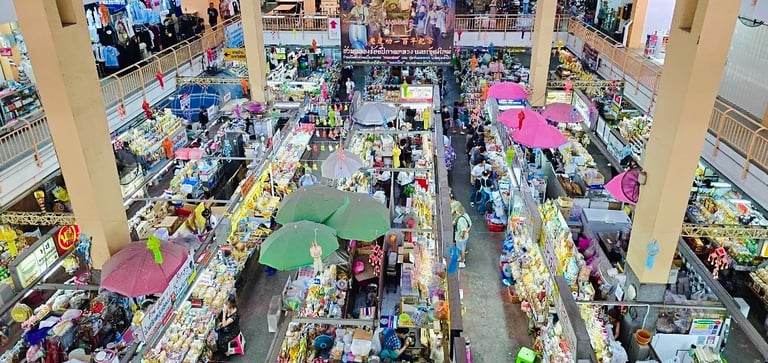

Conclusion: The Perfect End to a Perfect Food Day
Eating your way through Chiang Mai is one of the greatest travel experiences you can have. It’s an adventure that engages all five senses. It’s a journey of discovery, one Moo Ping skewer and one bowl of Khao Soi at a time.
But it’s also an adventure that can be... tiring.
After an evening of walking for hours, standing in line, braving the chili, and filling your belly with glorious new foods, your body will be talking to you. Your feet will be sore from the pavement. Your back might be tight from hunching over a low plastic stool. And your stomach, full and happy, will be working overtime.
This is where your foodie adventure and your self-care journey meet.
There is no better way to end a day of culinary exploration than with a restorative massage. At C&R Thai Massage, we see travelers like you every day. They come in, happy and full, but physically exhausted. A 60-minute Foot Massage can erase the miles you walked on the hard pavement. A full Traditional Thai Massage isn't just relaxing; it can aid digestion by gently stimulating the abdomen and helps your body process the incredible feast you just enjoyed.
Think of it as the final, perfect course of your meal. You’ve treated your palate; now it’s time to treat your body. So go out, eat boldly, and when you’re done, come see us. We’ll be here to help you rest, digest, and get ready to do it all again tomorrow.
Branch 1: Sunday Walking Street
(10 AM - 10PM)
Address: 145/8 Rajdamnern Road T. Prasingh
A. Mueng Chiang Mai 50200
Branch 2: Chiang Mai Gate
(10 AM - 10PM)
Address: 18/5 Rat Chiang Saen Road T. Hai Ya
A. Mueng Chiang Mai 50100
Phone Number:
+66 (0) 96 696 2874
+66 (0) 94 601 6207
Email: services.crgroup@gmail.com
